
Instruction Manual and Experiment Guide BASIC CURRENT BALANCE AND CURRENT BALANCE ACCESSORY SF-8607 Basic Current Balance SF-8608 Current Balance Accessory Shanghai JiaoTong University Center of Physics Experiment
Instruction Manual and Experiment Guide BASIC CURRENT BALANCE AND CURRENT BALANCE ACCESSORY Shanghai JiaoTong University Center of Physics Experiment

Table of contents Section Page Introduction......... Equipment.………… Operation..... Experiment Experiment 1:Force versus Current..................................... Experiment2:Force versus Length ofWire........................ Experiment 3:Force versus Magnetic Field................... Experiment 4:Force versus angle... Maintenance...…....….…
Table of contents Section Page Introduction…………………………………………………………….. Equipment ….…………….………………………………………….… Operation……………….………………………………………….…... Experiment Experiment 1: Force versus Current……………………………….. Experiment 2: Force versus Length of Wire………………….…… Experiment 3: Force versus Magnetic Field……………...……….. Experiment 4: Force versus angle………..……………………….. Maintenance……………………………………………………………
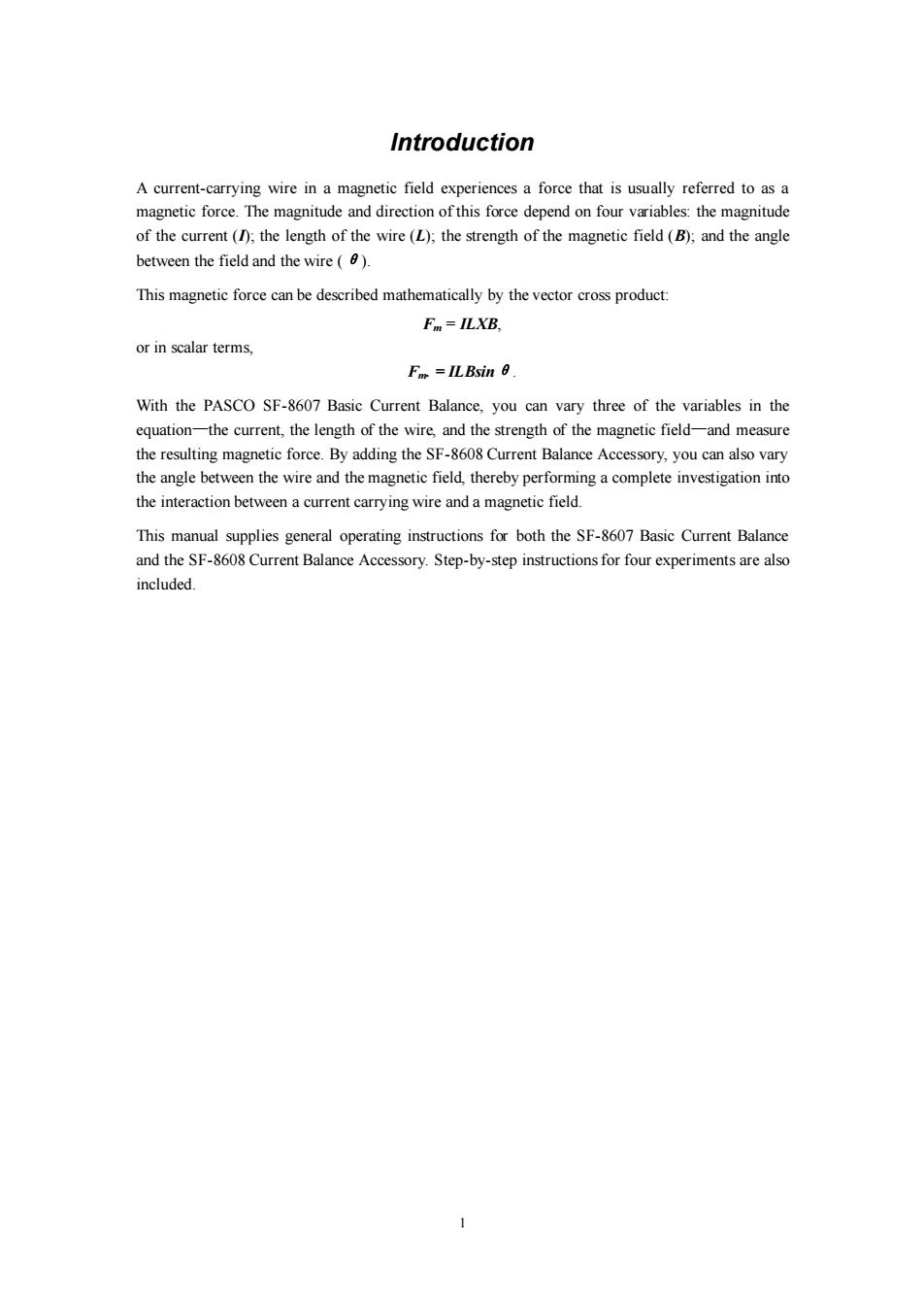
Introduction A current-carrying wire in a magnetic field experiences a force that is usually referred to as a magnetic force.The magnitude and direction of this force depend on four variables:the magnitude of the current (D);the length of the wire(L);the strength of the magnetic field(B);and the angle between the field and the wire(). This magnetic force can be described mathematically by the vector cross product: Fm=ILXB, or in scalar terms, Fmr =ILBsin 0 With the PASCO SF-8607 Basic Current Balance,you can vary three of the variables in the equation-the current,the length of the wire,and the strength of the magnetic field-and measure the resulting magnetic force.By adding the SF-8608 Current Balance Accessory,you can also vary the angle between the wire and the magnetic field,thereby performing a complete investigation into the interaction between a current carrying wire and a magnetic field. This manual supplies general operating instructions for both the SF-8607 Basic Current Balance and the SF-8608 Current Balance Accessory.Step-by-step instructions for four experiments are also included
1 Introduction A current-carrying wire in a magnetic field experiences a force that is usually referred to as a magnetic force. The magnitude and direction of this force depend on four variables: the magnitude of the current (I); the length of the wire (L); the strength of the magnetic field (B); and the angle between the field and the wire (θ). This magnetic force can be described mathematically by the vector cross product: Fm = ILXB, or in scalar terms, Fm. = ILBsinθ. With the PASCO SF-8607 Basic Current Balance, you can vary three of the variables in the equation—the current, the length of the wire, and the strength of the magnetic field—and measure the resulting magnetic force. By adding the SF-8608 Current Balance Accessory, you can also vary the angle between the wire and the magnetic field, thereby performing a complete investigation into the interaction between a current carrying wire and a magnetic field. This manual supplies general operating instructions for both the SF-8607 Basic Current Balance and the SF-8608 Current Balance Accessory. Step-by-step instructions for four experiments are also included
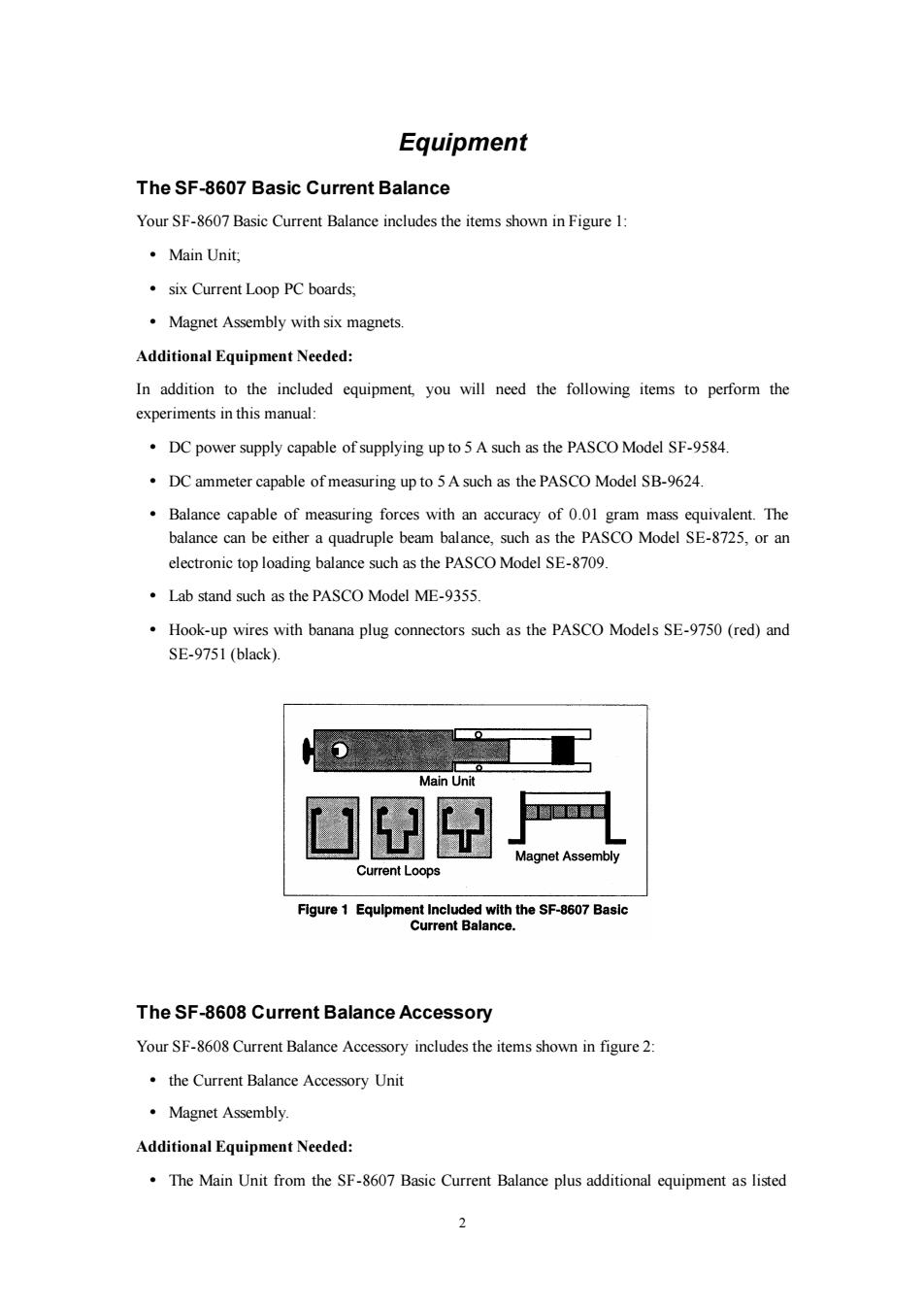
Equipment The SF-8607 Basic Current Balance Your SF-8607 Basic Current Balance includes the items shown in Figure 1: ·Main Unit, six Current Loop PC boards; Magnet Assembly with six magnets. Additional Equipment Needed: In addition to the included equipment,you will need the following items to perform the experiments in this manual: DC power supply capable of supplying up to 5 A such as the PASCO Model SF-9584. DC ammeter capable of measuring up to 5 A such as the PASCO Model SB-9624. Balance capable of measuring forces with an accuracy of 0.01 gram mass equivalent.The balance can be either a quadruple beam balance,such as the PASCO Model SE-8725,or an electronic top loading balance such as the PASCO Model SE-8709. Lab stand such as the PASCO Model ME-9355. Hook-up wires with banana plug connectors such as the PASCO Models SE-9750(red)and SE-9751(black). Main Unit Magnet Assembly Current Loops Figure 1 Equlpment Included with the SF-8607 Basic Current Balance. The SF-8608 Current Balance Accessory Your SF-8608 Current Balance Accessory includes the items shown in figure 2: the Current Balance Accessory Unit ·Magnet Assembly. Additional Equipment Needed: The Main Unit from the SF-8607 Basic Current Balance plus additional equipment as listed 2
2 Equipment The SF-8607 Basic Current Balance Your SF-8607 Basic Current Balance includes the items shown in Figure 1: Main Unit; six Current Loop PC boards; Magnet Assembly with six magnets. Additional Equipment Needed: In addition to the included equipment, you will need the following items to perform the experiments in this manual: DC power supply capable of supplying up to 5 A such as the PASCO Model SF-9584. DC ammeter capable of measuring up to 5 A such as the PASCO Model SB-9624. Balance capable of measuring forces with an accuracy of 0.01 gram mass equivalent. The balance can be either a quadruple beam balance, such as the PASCO Model SE-8725, or an electronic top loading balance such as the PASCO Model SE-8709. Lab stand such as the PASCO Model ME-9355. Hook-up wires with banana plug connectors such as the PASCO Models SE-9750 (red) and SE-9751 (black). The SF-8608 Current Balance Accessory Your SF-8608 Current Balance Accessory includes the items shown in figure 2: the Current Balance Accessory Unit Magnet Assembly. Additional Equipment Needed: The Main Unit from the SF-8607 Basic Current Balance plus additional equipment as listed
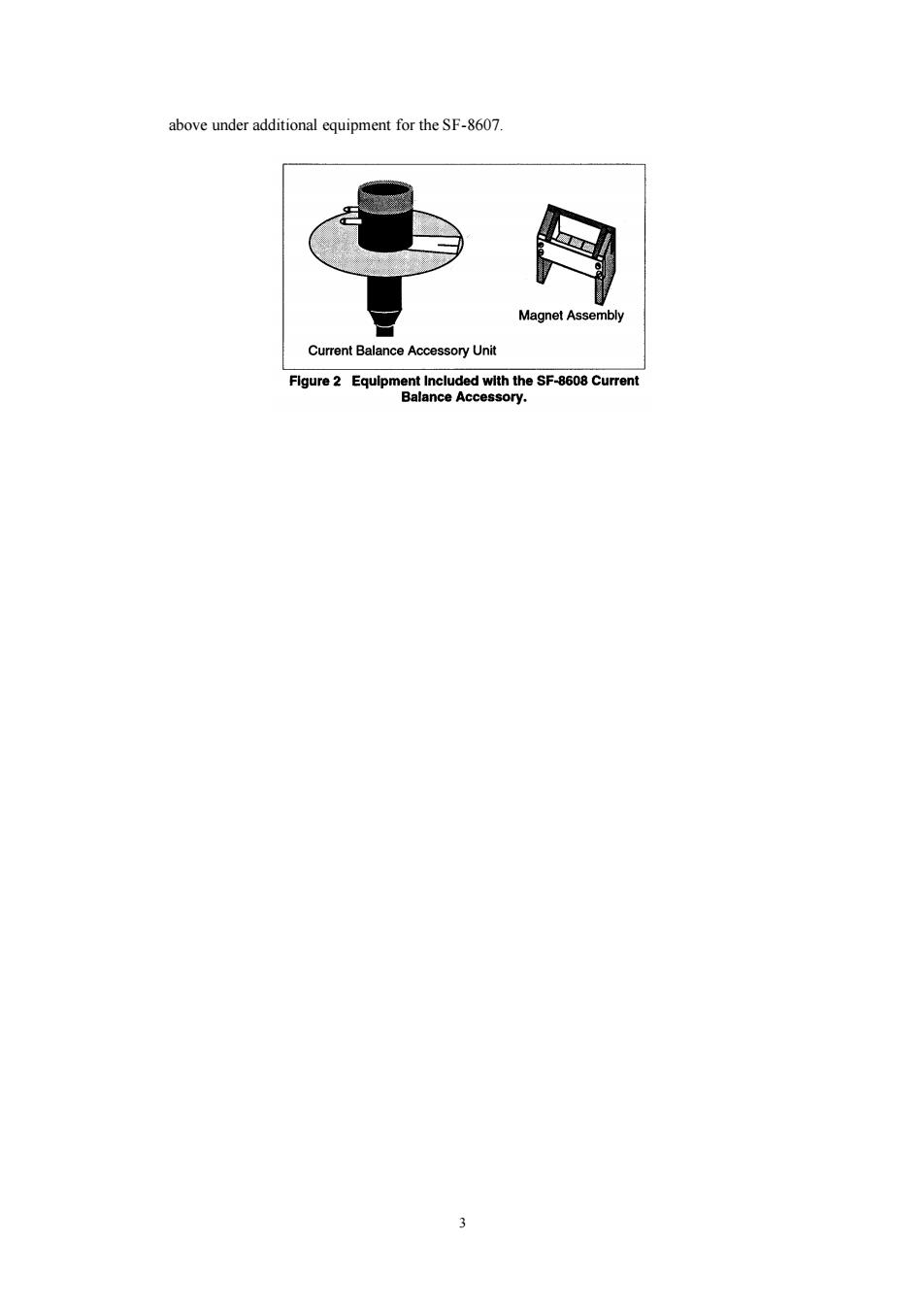
above under additional equipment for the SF-8607. Magnet Assembly Current Balance Accessory Unit Flgure 2 Equlpment Included with the SF-8608 Current Balance Accessory. 3
3 above under additional equipment for the SF-8607
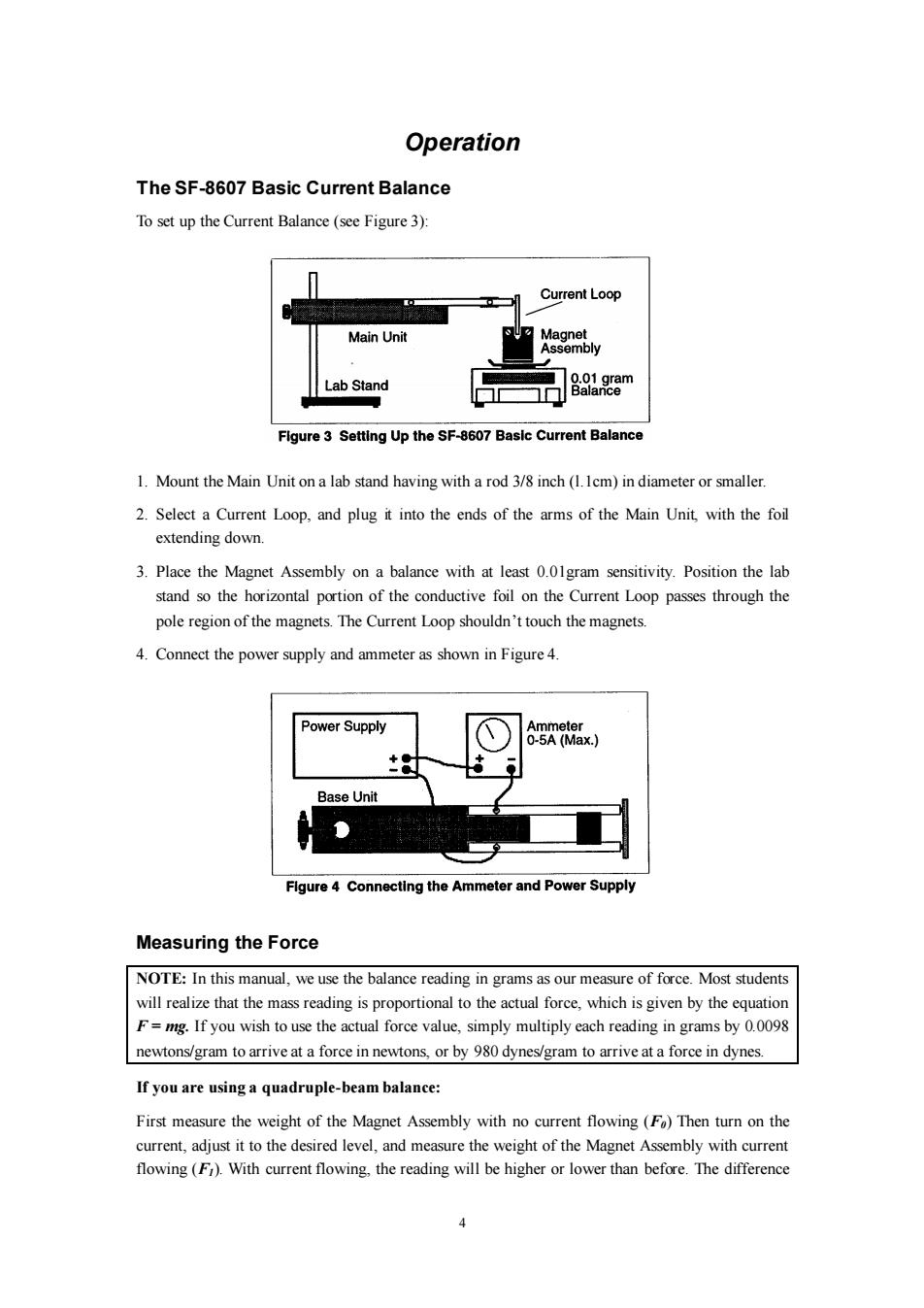
Operation The SF-8607 Basic Current Balance To set up the Current Balance(see Figure 3): Current Loop Main Unit Magnet Assembly Lab Stand 89a8m Flgure 3 Setting Up the SF-8607 Basic Current Balance 1.Mount the Main Unit on a lab stand having with a rod 3/8 inch(1.Icm)in diameter or smaller. 2.Select a Current Loop,and plug it into the ends of the arms of the Main Unit,with the foil extending down. 3.Place the Magnet Assembly on a balance with at least 0.01gram sensitivity.Position the lab stand so the horizontal portion of the conductive foil on the Current Loop passes through the pole region of the magnets.The Current Loop shouldn't touch the magnets. 4.Connect the power supply and ammeter as shown in Figure 4. Power Supply Ammeter 0-5A(Max.) +● Base Unit Flgure 4 Connecting the Ammeter and Power Supply Measuring the Force NOTE:In this manual,we use the balance reading in grams as our measure of force.Most students will realize that the mass reading is proportional to the actual force,which is given by the equation F=mg.If you wish to use the actual force value,simply multiply each reading in grams by 0.0098 newtons/gram to arrive at a force in newtons,or by 980 dynes/gram to arrive at a force in dynes. If you are using a quadruple-beam balance: First measure the weight of the Magnet Assembly with no current flowing(Fo)Then turn on the current,adjust it to the desired level,and measure the weight of the Magnet Assembly with current flowing(F).With current flowing,the reading will be higher or lower than before.The difference
4 Operation The SF-8607 Basic Current Balance To set up the Current Balance (see Figure 3): 1. Mount the Main Unit on a lab stand having with a rod 3/8 inch (l.1cm) in diameter or smaller. 2. Select a Current Loop, and plug it into the ends of the arms of the Main Unit, with the foil extending down. 3. Place the Magnet Assembly on a balance with at least 0.01gram sensitivity. Position the lab stand so the horizontal portion of the conductive foil on the Current Loop passes through the pole region of the magnets. The Current Loop shouldn’t touch the magnets. 4. Connect the power supply and ammeter as shown in Figure 4. Measuring the Force NOTE: In this manual, we use the balance reading in grams as our measure of force. Most students will realize that the mass reading is proportional to the actual force, which is given by the equation F = mg. If you wish to use the actual force value, simply multiply each reading in grams by 0.0098 newtons/gram to arrive at a force in newtons, or by 980 dynes/gram to arrive at a force in dynes. If you are using a quadruple-beam balance: First measure the weight of the Magnet Assembly with no current flowing (F0) Then turn on the current, adjust it to the desired level, and measure the weight of the Magnet Assembly with current flowing (F1). With current flowing, the reading will be higher or lower than before. The difference
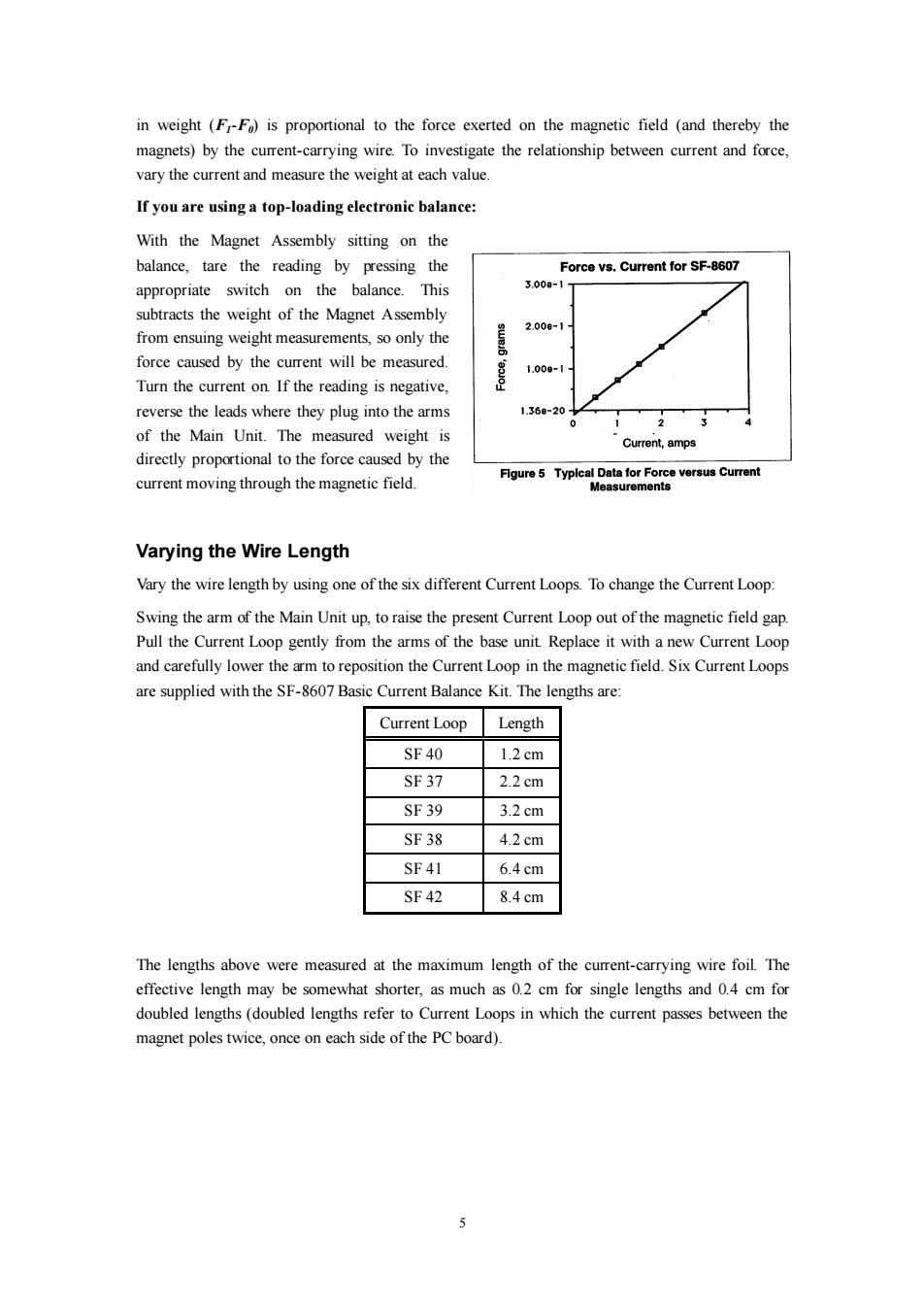
in weight (F-F)is proportional to the force exerted on the magnetic field (and thereby the magnets)by the current-carrying wire.To investigate the relationship between current and force, vary the current and measure the weight at each value. If you are using a top-loading electronic balance: With the Magnet Assembly sitting on the balance,tare the reading by pressing the Force vs.Current for SF-8607 appropriate switch on the balance.This 3.00a-1 subtracts the weight of the Magnet Assembly 2.008-1 from ensuing weight measurements,so only the force caused by the current will be measured. 1.00-1 Turn the current on.If the reading is negative, reverse the leads where they plug into the arms 1.369-201 2 of the Main Unit.The measured weight is Current,amps directly proportional to the force caused by the Figure 5 Typical Data for Force versus Current current moving through the magnetic field. Measurements Varying the Wire Length Vary the wire length by using one of the six different Current Loops.To change the Current Loop: Swing the arm of the Main Unit up,to raise the present Current Loop out of the magnetic field gap. Pull the Current Loop gently from the arms of the base unit.Replace it with a new Current Loop and carefully lower the arm to reposition the Current Loop in the magnetic field.Six Current Loops are supplied with the SF-8607 Basic Current Balance Kit.The lengths are: Current Loop Length SF40 1.2cm SF37 2.2cm SF39 3.2cm SF38 4.2cm SF41 6.4cm SF42 8.4cm The lengths above were measured at the maximum length of the current-carrying wire foil.The effective length may be somewhat shorter,as much as 0.2 cm for single lengths and 0.4 cm for doubled lengths(doubled lengths refer to Current Loops in which the current passes between the magnet poles twice,once on each side of the PC board). J
5 in weight (F1-F0) is proportional to the force exerted on the magnetic field (and thereby the magnets) by the current-carrying wire. To investigate the relationship between current and force, vary the current and measure the weight at each value. If you are using a top-loading electronic balance: With the Magnet Assembly sitting on the balance, tare the reading by pressing the appropriate switch on the balance. This subtracts the weight of the Magnet Assembly from ensuing weight measurements, so only the force caused by the current will be measured. Turn the current on. If the reading is negative, reverse the leads where they plug into the arms of the Main Unit. The measured weight is directly proportional to the force caused by the current moving through the magnetic field. Varying the Wire Length Vary the wire length by using one of the six different Current Loops. To change the Current Loop: Swing the arm of the Main Unit up, to raise the present Current Loop out of the magnetic field gap. Pull the Current Loop gently from the arms of the base unit. Replace it with a new Current Loop and carefully lower the arm to reposition the Current Loop in the magnetic field. Six Current Loops are supplied with the SF-8607 Basic Current Balance Kit. The lengths are: Current Loop Length SF 40 1.2 cm SF 37 2.2 cm SF 39 3.2 cm SF 38 4.2 cm SF 41 6.4 cm SF 42 8.4 cm The lengths above were measured at the maximum length of the current-carrying wire foil. The effective length may be somewhat shorter, as much as 0.2 cm for single lengths and 0.4 cm for doubled lengths (doubled lengths refer to Current Loops in which the current passes between the magnet poles twice, once on each side of the PC board)
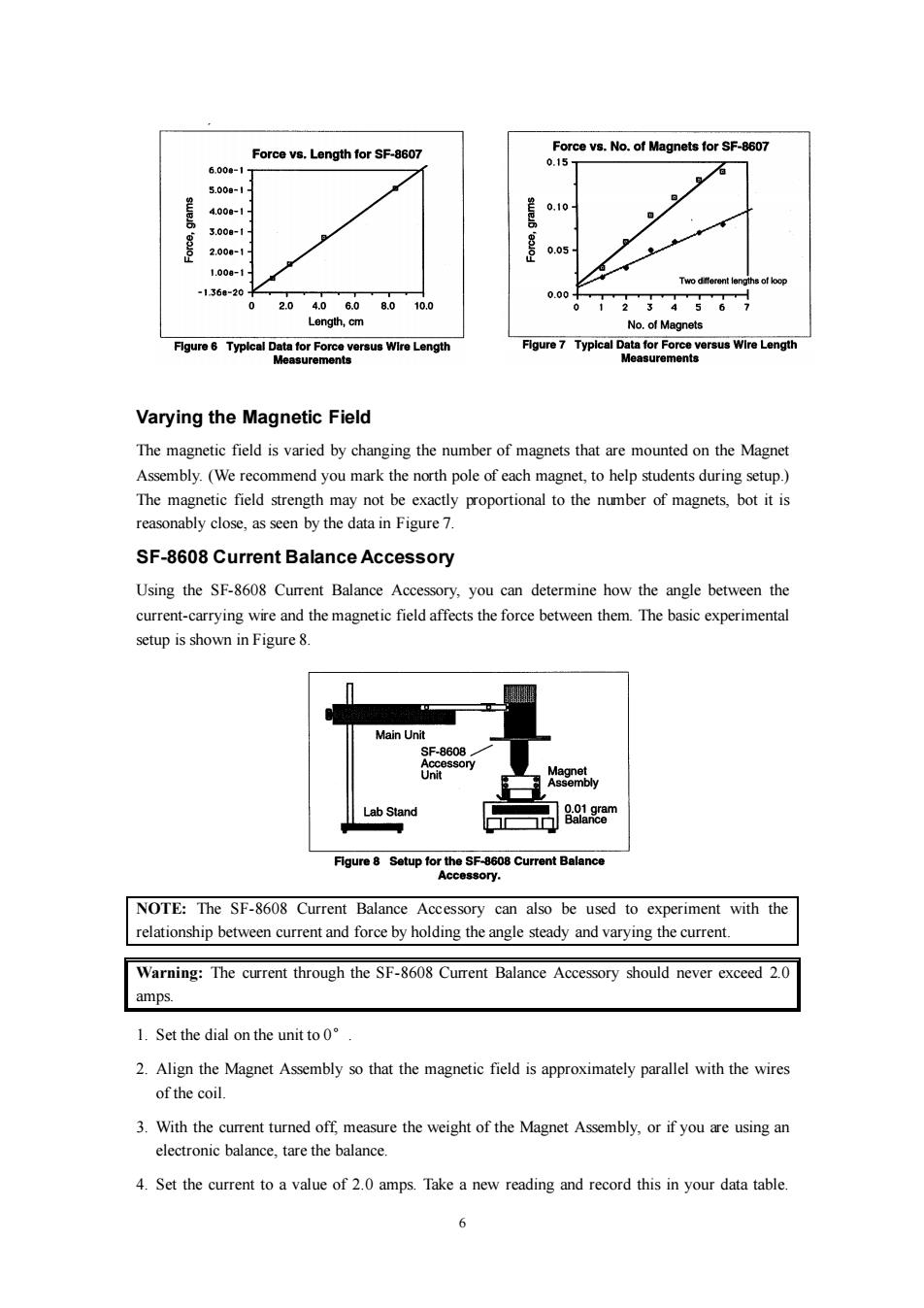
Force vs.Length for SF-8607 Force vs.No.of Magnets for SF-8607 0.15 6.000-1 6 5.008-1 4.008-1 0,10- 3008-1 8 2.000-1 0.05 1.00a-1 -136e-20 0.00+ 0 2.04.06.08.010.0 0 246 Length,cm No.of Magnets Flgure 6 Typlcal Data for Force versus Wire Length Flgure 7 Typlcal Data for Force versus Wire Length Measurements Measurements Varying the Magnetic Field The magnetic field is varied by changing the number of magnets that are mounted on the Magnet Assembly.(We recommend you mark the north pole of each magnet,to help students during setup.) The magnetic field strength may not be exactly proportional to the number of magnets,bot it is reasonably close,as seen by the data in Figure 7. SF-8608 Current Balance Accessory Using the SF-8608 Current Balance Accessory,you can determine how the angle between the current-carrying wire and the magnetic field affects the force between them.The basic experimental setup is shown in Figure 8. Main Unit SF.8608 Accessory Unit sembly Lab Stand Figure 8 Setup for the SF-8608 Current Balance Accessory. NOTE:The SF-8608 Current Balance Accessory can also be used to experiment with the relationship between current and force by holding the angle steady and varying the current. Warning:The current through the SF-8608 Current Balance Accessory should never exceed 2.0 amps. 1.Set the dial on the unit to0 2.Align the Magnet Assembly so that the magnetic field is approximately parallel with the wires of the coil. 3.With the current turned off,measure the weight of the Magnet Assembly,or if you are using an electronic balance,tare the balance. 4.Set the current to a value of 2.0 amps.Take a new reading and record this in your data table. 6
6 Varying the Magnetic Field The magnetic field is varied by changing the number of magnets that are mounted on the Magnet Assembly. (We recommend you mark the north pole of each magnet, to help students during setup.) The magnetic field strength may not be exactly proportional to the number of magnets, bot it is reasonably close, as seen by the data in Figure 7. SF-8608 Current Balance Accessory Using the SF-8608 Current Balance Accessory, you can determine how the angle between the current-carrying wire and the magnetic field affects the force between them. The basic experimental setup is shown in Figure 8. NOTE: The SF-8608 Current Balance Accessory can also be used to experiment with the relationship between current and force by holding the angle steady and varying the current. Warning: The current through the SF-8608 Current Balance Accessory should never exceed 2.0 amps. 1. Set the dial on the unit to 0°. 2. Align the Magnet Assembly so that the magnetic field is approximately parallel with the wires of the coil. 3. With the current turned off, measure the weight of the Magnet Assembly, or if you are using an electronic balance, tare the balance. 4. Set the current to a value of 2.0 amps. Take a new reading and record this in your data table
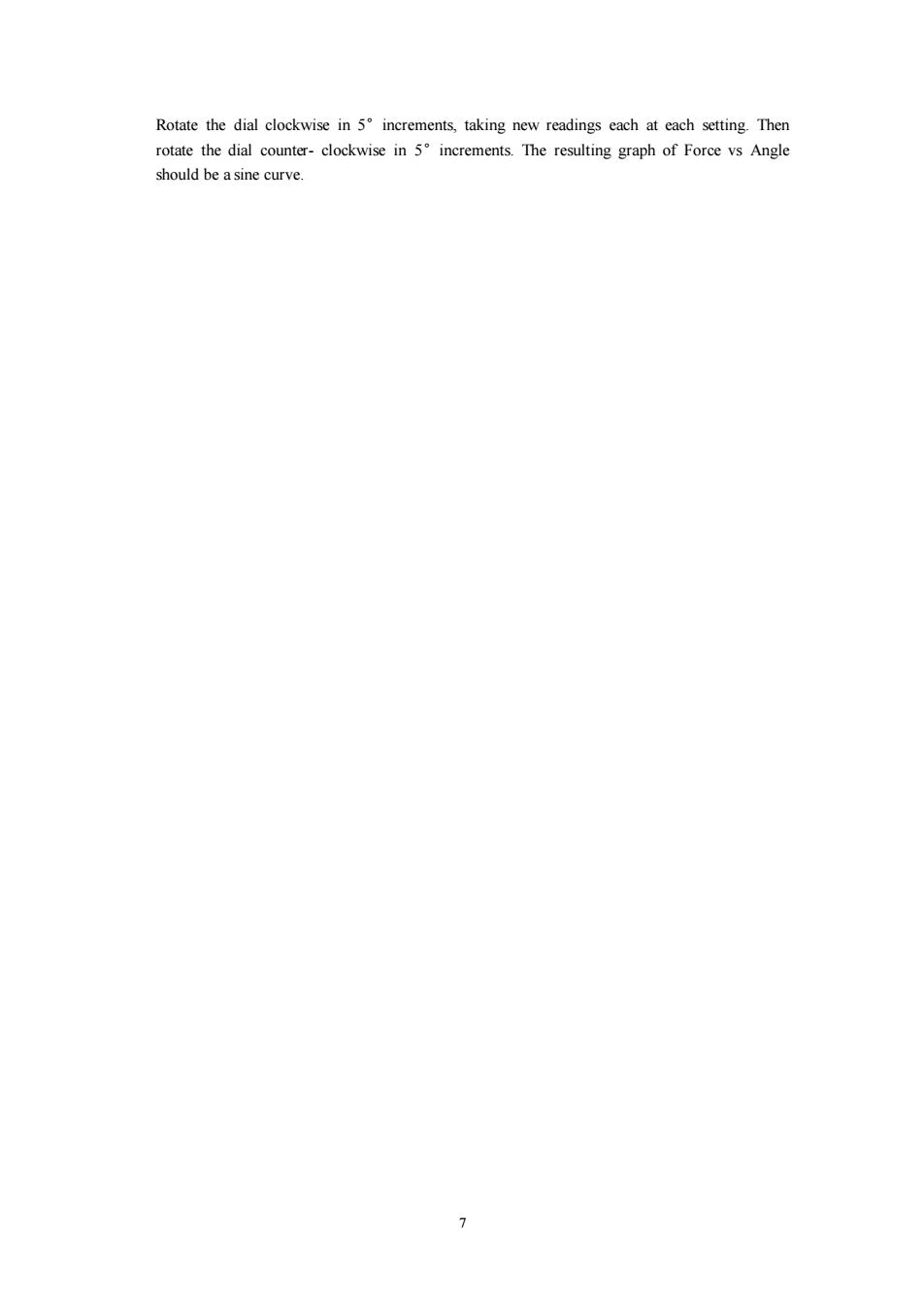
Rotate the dial clockwise in 5 increments,taking new readings each at each setting.Then rotate the dial counter-clockwise in 5 increments.The resulting graph of Force vs Angle should be a sine curve. >
7 Rotate the dial clockwise in 5°increments, taking new readings each at each setting. Then rotate the dial counter- clockwise in 5°increments. The resulting graph of Force vs Angle should be a sine curve

Experiment 1:Force versus Current Procedure If you're using a quadruple-beam balance: 1.Set up the apparatus as shown in figure 1.1. Current Loop 2.Determine the mass of the magnet holder and magnets with no current flowing.Record this Main Unit Magnet value in the column under "Mass"in Table Assembly 1.1. Lab Stand 0.01 gram Balance 3.Set the current to 0.5 amp.Determine the new “mass”of the magnet assembly..Record this Flgure 1.1 Equlpment Setup value under"Mass"in Table 1.1. 4.Subtract the mass value with the current flowing from the value with no current flowing Record this difference as the“Force” 5.Increase the current in 0.5 amp increments to a maximum of 5.0 amp,each time repeating steps 2-4. If you're using an electronic balance: 1.Set up the apparatus as shown in figure 1.1. 2.Place the magnet assembly on the pan of the balance.With no current flowing,press the TARE button,bringing the reading to 0.00 grams. 3.Now turn the current on to 0.5 amp,and record the mass value in the "Force"column of Table 1.1. 4.Increase the current in 0.5 amp increments to a maximum of 5.0 amp,each time recording the new“Force'”value. Data Processing Plot a graph of Force(vertical axis)versus Current(horizontal axis) Analysis What is the nature of the relationship between these two variables?What does this tell us about how changes in the current will affect the force acting on a wire that is inside a magnetic field?
8 Experiment 1: Force versus Current Procedure If you're using a quadruple-beam balance: 1. Set up the apparatus as shown in figure 1.1. 2. Determine the mass of the magnet holder and magnets with no current flowing. Record this value in the column under “Mass” in Table 1.1. 3. Set the current to 0.5 amp. Determine the new “mass” of the magnet assembly. Record this value under “Mass” in Table 1.l. 4. Subtract the mass value with the current flowing from the value with no current flowing. Record this difference as the “Force”. 5. Increase the current in 0.5 amp increments to a maximum of 5.0 amp, each time repeating steps 2-4. If you're using an electronic balance: 1. Set up the apparatus as shown in figure 1.1. 2. Place the magnet assembly on the pan of the balance. With no current flowing, press the TARE button, bringing the reading to 0.00 grams. 3. Now turn the current on to 0.5 amp, and record the mass value in the “Force” column of Table 1.1. 4. Increase the current in 0.5 amp increments to a maximum of 5.0 amp, each time recording the new “Force” value. Data Processing Plot a graph of Force (vertical axis) versus Current (horizontal axis). Analysis What is the nature of the relationship between these two variables? What does this tell us about how changes in the current will affect the force acting on a wire that is inside a magnetic field?